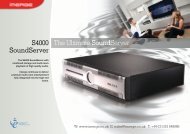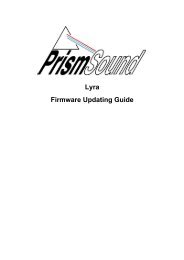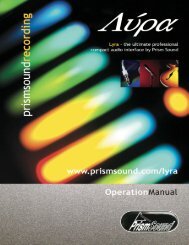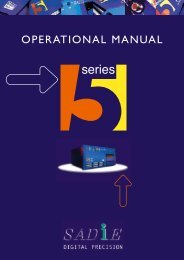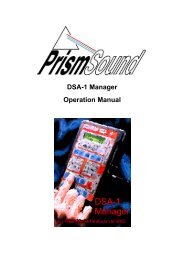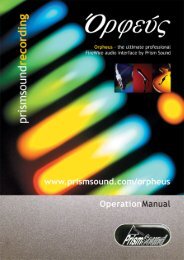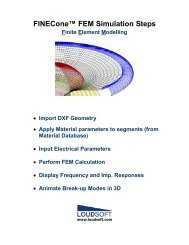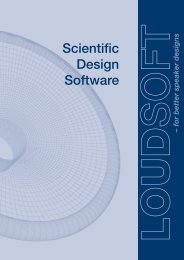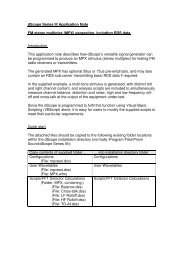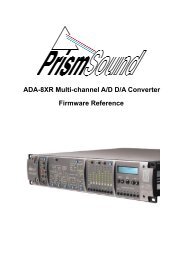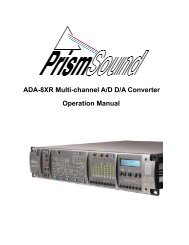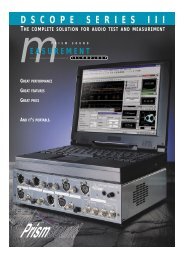ADA-8XR Multi-channel A/D D/A Converter Operation Manual
ADA-8XR Multi-channel A/D D/A Converter Operation Manual
ADA-8XR Multi-channel A/D D/A Converter Operation Manual
You also want an ePaper? Increase the reach of your titles
YUMPU automatically turns print PDFs into web optimized ePapers that Google loves.
Prism Sound <strong>ADA</strong>-<strong>8XR</strong> <strong>Multi</strong>-<strong>channel</strong> A/D D/A <strong>Converter</strong> <strong>Operation</strong> <strong>Manual</strong> - Revision 1.00<br />
converted data, up to a maximum just short of half the selected rate. In the case of D/A or<br />
D/D Paths, the choice of sample rate is usually made for us since incoming data has already<br />
been sampled at a particular rate.<br />
7.2.2 What is the use of extended sample rates<br />
Whether the inclusion of extended audio frequencies in an A/D conversion (i.e. above the<br />
20kHz-ish imposed for, say, 44.1kHz sampling) is beneficial is still being debated. The<br />
general listener opinion is that it really does give improved sound quality, although it is worth<br />
bearing in mind that nearly all comparative tests have tended to involve setups where ‘A’ and<br />
‘B’ differ by far more than just the sample rate. Assuming, then, that there is an improvement,<br />
there is much disagreement as to why this might be. There is little or no ‘scientific’ evidence<br />
to suggest that anyone can hear sounds above about 25kHz, with sensitivity above 20kHz<br />
being non-existent for the vast majority. There has been much discussion as to whether the<br />
presence of high frequencies which would be imperceptible alone, can cause changes to the<br />
rendition of lower frequencies.<br />
Perhaps a more likely explanation for the improvement in perceived quality at higher sample<br />
rates cites implementation limitations of the digital (or analogue) anti-aliasing filters within<br />
current ‘off-the-shelf’ converter devices. These filters have traditionally been designed with<br />
very sudden high-frequency roll-off in order to maximise the available audio bandwidth at<br />
barely-adequate sample rates. This requirement, coupled with practical limitations in filter<br />
complexity, have led to compromised designs with significant ripple in the passband (and<br />
sometimes inadequate attenuation in the stop-band). In addition, these very steep filters<br />
often result in unwanted temporal distortion: i.e. discrete pre- and post- echo effects. There is<br />
speculation as to why and how these might be noticeable, but experiments carried out with<br />
‘no-compromise’ filter designs (at traditional sample rates) which eliminate these echoes,<br />
suggest that their removal renders the sampled signal subjectively indistinguishable from the<br />
original analogue. So perhaps very extended sample rates are not strictly necessary; on the<br />
other hand, an inadequate filter operating at extended rates produces echoes proportionately<br />
nearer in time to the actual signal than it does at lower rates, which are likely to be less<br />
noticeable. If this theory proves to be correct, it will cast doubt on the usefulness of the ‘4x’<br />
rates (e.g. 176.4kHz or 192kHz) and above, since the transition band is already comfortably<br />
wide enough at 96kHz to eliminate echoes, with cheaply-realisable filters rolling off<br />
comfortably beyond audible frequencies.<br />
7.2.3 Interfacing extended sample rates<br />
When extended sample rates were first experimented with, it was difficult to operate the<br />
preferred AES3 interface format at twice its normal rate (not that difficult, actually, but existing<br />
interface devices wouldn’t work), and so early 96kHz equipment used two AES3 interfaces<br />
each running at 48kHz; instead of carrying a stereo signal, each interface carried one <strong>channel</strong><br />
with its ‘odd’ and ‘even’ samples placed as if ‘left’ and ‘right’.<br />
Although offensive to engineering types, this approach had unexpected advantages<br />
operationally – you could use your existing AES3 routers and multi-<strong>channel</strong> recorders (albeit<br />
with half the <strong>channel</strong> density) to work at 96kHz.<br />
This method of interfacing between equipment is referred to variously as ‘Two-wire’ or<br />
‘Split96’ AES3.<br />
Later, manufacturers began to implement extended sample-rate interfaces by operating an<br />
AES3 interface at twice the ‘normal’ speed. This method of interfacing is usually referred to as<br />
‘Double-speed’ or ‘One-wire’ AES3.<br />
Direct interconnection of the two interfaces is not possible, although the effects of connecting<br />
half of a Split96 output to a ‘normal’ input have occasionally caused embarrassing confusion!<br />
© Prism Media Products Limited, 2001-2004 Page 1.27



